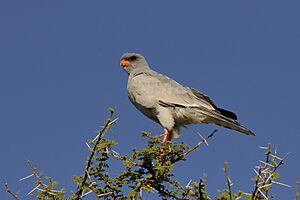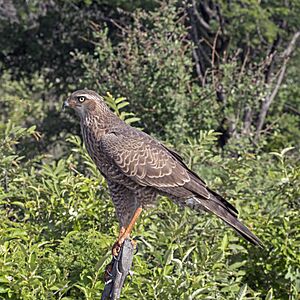Pale chanting goshawk facts for kids
Quick facts for kids Pale chanting goshawk |
|
|---|---|
 |
|
| Conservation status | |
| Scientific classification | |
| Subspecies | |
|

The pale chanting goshawk (Melierax canorus) is a type of bird of prey. It belongs to the Accipitridae family, which includes hawks and eagles. This hawk lives in southern Africa. It prefers dry, open areas like semi-deserts, where there isn't much rain. You can often spot it sitting on telephone poles along roads.
Contents
Description
These birds are about 55 cm (22 inches) long. Their wings can spread out to 110 cm (43 inches).
What Adults Look Like
Adult goshawks have grey feathers on their backs and a white patch above their tail. Their central tail feathers are black with white tips. The outer tail feathers have grey and white stripes. Their head and upper chest are light grey. The rest of their underside has fine dark grey and white stripes. Adult goshawks have dark brown eyes. Their beak is red at the bottom and dark grey at the tip. Their face, skin, and long legs are also red.
What Young Birds Look Like
Young goshawks have brown feathers on their backs. They also have a white patch above their tail. Their tail has black stripes. From below, their flight feathers and tail are white with black stripes. Their throat is white with dark streaks. The rest of their underside is reddish-brown.
How to Tell Them Apart
The pale chanting goshawk is larger and lighter in color than its relative, the dark chanting goshawk (Melierax metabates).
Their Call
Both male and female goshawks make a lot of noise during breeding season. Their call sounds like a musical whistle: kleeu-kleeu-kleeu-ku-ku-ku. They usually make this sound from the top of a tree.
Ecology
What They Eat and How They Hunt
The pale chanting goshawk usually hunts from high places. These can be trees or telephone poles. But it also walks on the ground to chase its prey. It is a very flexible hunter and eats many different things. This includes small mammals like Cape hares, lizards, other birds, and large insects. They also eat dead animals.
They have even been seen eating baby tent tortoises and leopard tortoises. They swallow these whole while their shells are still soft. Sometimes, goshawks in breeding groups hunt together. However, they usually hunt alone. Pale chanting goshawks often hunt near honey badgers. They eat the small animals that the honey badgers scare out of hiding. This helps the goshawks catch more food, and it doesn't bother the honey badgers.
Reproduction and Life Cycle
Pale chanting goshawks build their nests from sticks. The nests are fairly small. They are built in trees, often Vachellia trees, between 2 and 12 meters (6.5 to 39 feet) high. They might also build nests on poles or pylons. They line their nests with soft materials. These can include animal fur, dry animal waste, nests from Cape penduline tits, cloth, or silk nests from social spiders.
The female lays one to three chalky white eggs, but usually two. She then sits on them to keep them warm. Most often, only one chick survives, but sometimes two chicks are raised. The breeding season starts in midwinter and lasts over 115 days. After the young birds leave the nest, they might stay nearby for several months. The next year, they might even try to find a mate in the same area. Some pairs, especially groups of three, will raise a second set of chicks. This happens about 24 days after the first chicks leave the nest.
Normally, one female mates with one male. This is called monogamy. But in some areas, like the Little Karoo, where there is a lot of food, one female might mate with two males. This is called polyandry. In these cases, a main male and the female will raise the young. A second male will help them. The main male mates with the female about 31 to 5 days before she lays eggs. The second male mates with her 5 to 3 days before she lays eggs. The second male helps by defending the nest and bringing food. This helps him have his own young in the future. Young birds from past broods might also stay in their home area and help the breeding group.
Where They Live
Pale chanting goshawks live across most of the dry parts of Southern Africa. They like dry semi-desert areas with open ground. They also need good perches, like trees or poles, to hunt from. They do not migrate, meaning they don't travel long distances for seasons. However, they do move around both short and long distances. In the Karoo region, one pair or family group uses an area between 4.4 and 8.6 square kilometers (1.7 to 3.3 square miles). Around Windhoek, one pair uses an area between 5.4 and 6.7 square kilometers (2.1 to 2.6 square miles).


